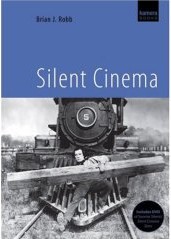
'Silent Cinema' By Brian J. Robb , Harpenden, Herts: Kamera
Books, 2007. ISBN 978 1 90404863 3 159pp. + DVD (softcover) £9.99
Although its purists and ardent admirers may beg to differ, silent
cinema is a hard entity to bring alive, given that its last true films
were made almost 80 years ago. It is still more difficult to take what could
be written and to distil it into what should be written to
capture the interest of both casual reader and cinematic enthusiast. In
his simply-titled book Silent Cinema however, Brian J. Robb has
achieved both these objectives. 12 chapters help to comprise 149 pages
of illustrated text followed by a useful “grab bag” of handy resources,
notes and an index.
Given the sheer scale of silent film production selecting the
sufficient balance of general facts and academia is not an easy one,
but Robb ensures the reader is quickly engaged with a swift discussion
of the origins of cinema per se which includes a superb
engraved picture of a Praxinoscope at work (p.7). Refreshingly, as well
as focusing in on the much-discussed first Lumiere film show on 28th
December 1895, Robb gives due credit to others who played a part in the
development of the medium (such as Louis Le Prince and William
Friese-Greene), often omitted from histories of this period. Then,
after a chapter about the cinema as a ‘developing art’, Robb sensibly
abandons a strictly chronological approach in favour of a focus on
specific influential individuals who worked throughout many years of
the silent era. Starting with Georges Melies (and giving that gentleman
due credit, again making a pleasant change from those who seek to
dismiss him as a mere trick film maker with an airy wave of the hand),
Robb then moves on to discuss directors, ‘dramatic stars’ and ‘silent
clowns’ in a tripartite section of chapters that forms the core of his
book.
The chapter dealing with ‘dramatic stars’ is additionally interesting
because, conversely, of the inclusion of an unnecessary piece of
“dumbing down”- a comparison to contemporary stars. Presumably placed
there as a helpful guide for the youthful 21st Century cineaste, the
inclusion of the ‘contemporary equivalent’ line undermines some of the
useful work within the mini biographies without any obvious merit.
Thus, William S. Hart and Tom Mix are still present in modern-day
cinema apparently…in the form of Bruce Willis; and the multi-faceted
Lillian Gish becomes the rather less faceted Gwyneth Paltrow. Given the
choice, I am sceptical whether Griffith would have cast Paltrow in Way
Down East- but then again Griffith himself probably has a modern
equivalent, although this (wisely) isn’t speculated upon. Perhaps the
luckiest star of all is Valentino- he is (again apparently) the
equivalent of
no less than four contemporary actors at varying stages of their
careers. This chapter is followed by one on silent screen comedians,
which thoroughly deals with the major players and pleasingly includes
reference to Harry Langdon, again an often-overlooked figure. Two
comedians who are largely omitted from this section are, surprisingly,
Stan Laurel and Oliver Hardy, although they are mentioned at
odd stages throughout the book as a whole.
The first 105 pages of Silent Cinema conclude with a
fascinating chapter about Hollywood scandals (an integral part of
silent film history) and a brief survey of international film
production during the silent era. It is a chapter such as this which
really marks the success of Robb’s book, for it provides some detail
rather than none, yet can be used in conjunction with other sources to
make further research a distinctly practical possibility. This chapter
leads on to a chronological discussion of 29 key silent films which
neatly encapsulates several genres, styles and talents, a clear example
of the sheer diversity of silent film production. With some notes about
the advent of sound the book’s narrative closes, what follows being a
useful section of resources plus notes and an index.
Overall, Brian J. Robb has done an excellent job in making the topic of
silent cinema not only accessible but very readable. His book is a nice
“sociable” size, well packaged with foldback card covers, and contains
an appropriate amount of good quality illustrations. Complimenting
this, the lively way in which the information is presented and
compressed into a neat volume should make it an ideal instant reference
book for any film fan, whatever the state of their cinema library.
Despite this, I feel the book will most appeal to those who wish to
educate others in the joys of silent cinema- as an affordable present
for a youngster interested in cinema history it presents a highly
interesting and well-written narrative much like the films discussed
within its pages.
An additional plus to this particular publication is the inclusion of a
DVD from Sunrise Silents, whose enthusiastic commitment to the
pre-sound era is both inspiring and gratifying. Conveniently chaptered,
the three hour DVD acts as a showcase of 27 performers from the silent
era ranging from Buster Keaton to Lon Chaney, Colleen Moore to Rin Tin
Tin. Beautifully tinted and carefully selected to show the range and
variety of silent filmmaking, the only downside is the absence of film
titles, directors and dates on the disc itself, which would have made
tracking down some of
these films that much easier. However, the simple presence of the DVD
itself is indicative of the care and attention that has gone into Silent
Cinema, which is most certainly a worthy addition to any serious
film library.
'Silent Cinema' is published by Kamera Books.
Kamera Books website
Back
Home

